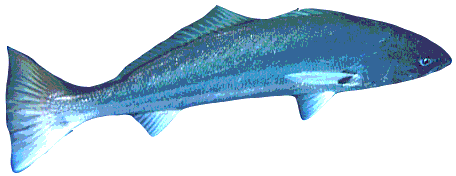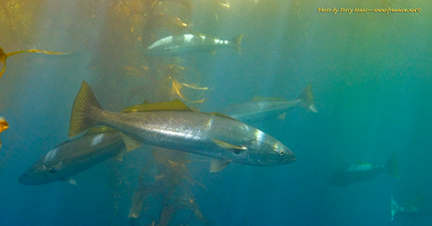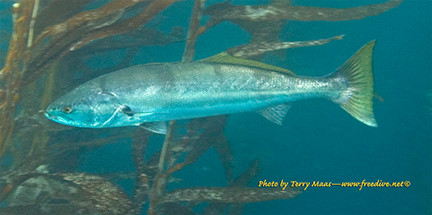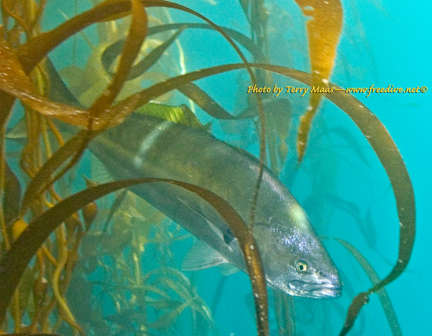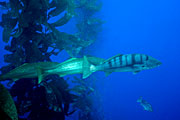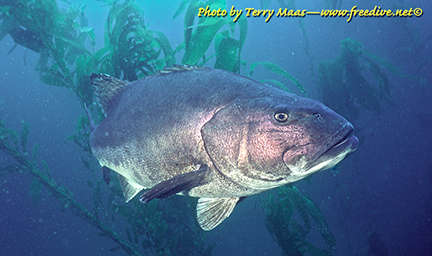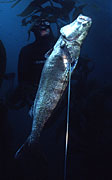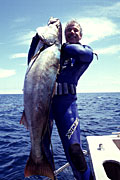|
Return of the White seabass
It’s spring; I’m 20 feet under the kelp canopy in green, 20-foot visibility when I hear the unmistakable staccato of white seabass croaking. Hyper-alert now, my heart racing in anticipation, I freeze and scan the small bubble of visibility surrounding me. Inching forward, I angle toward a small, cathedral-like clearing where shafts of light flicker into the green water room where white seabass (WSB) like to gather.
Suddenly, something shimmering catches my eye at the edge of visibility. "Slow down, be quiet," I tell myself as I glide forward. I’m not sure what I’m seeing but the ghost-like illusion keeps pace. Out of air, I begin to ascend. One last glance confirms my hope as a flicker from a yellowish WSB tail disappears into the gloom. Knowing that I cannot dive straight back into the kelp room, I slowly and silently backtrack on the surface so that I’m again in position to re-enter the clearing, camouflaged behind the heavy kelp. I tip over quietly making sure that my fins don’t splash. I open my mouth flooding my snorkel so that no bubbles escape. Returning to the cathedral, I angle toward the spot where the tail disappeared. This time the unmistakable shapes of two whites appear. They swim faster as they sense me approaching. For a few seconds, I close the gap, enough to see that one fish is huge—maybe 60 pounds. My painful ears tell me it’s now 40 feet, yet I still need to be several feet closer for a good shot. Slowly, I bring up my hand to clear my ears and I hear the smallest of squeaks—so did the whites. My two fish bolted with twin booms as their tails cavitated the water followed by 20 more booms. Damn! I spooked a whole school. I’ll be lucky to find another fish in this kelp forest today. I missed another chance to at the most sought after game fish in California.
I have hunted WSB for years with a spear. This fish is so shy that freedivers normally take their shot when the fish comes within range. One day I came upon a 20-lb fish cruising the blue-water edge of the kelp forest. Instead of spearing it as soon as it came within range, I decided to see just how close I could approach this fish. Closer and closer I came until I was within 6 feet. Just as I thought I’d seen the best sight of my career, a pacific yellowtail came streaking in from the blue and butted the WSB on its side sending it scurrying. How I wished I’d had a camera! While spearfishers have a tough time approaching within 15 feet of these animals, the photographer’s challenge is even more difficult. Because whites like green water under the kelp canopy, generally under overcast skies, you need to sneak very close to capture these fish on film.
The best time to photograph WSB is when they are preoccupied with food or sex. They hunt schools of mackerel or sardines streaming between kelp stringers. You can be sure whites are near if these bait fish bear scars from recent WSB hunting forays. When the bait fish form into tight balls, you can expect whites to be lurking at the edges waiting for a chance to rush the school. Shaped long and slender, white seabass are like chameleons, adopting different color schemes to match their environment and their mood. Outside the kelp forest, they become silver sporting gorgeous, iridescent-purple stripes across the length of their backs. Breeding females display large dark vertical zebra-like bands. If you are very lucky, you might find a courting band of WSB, usually several 20- to 30-pound light colored male escorts rubbing and slapping their sides against a 40-pound or larger, single striped female. When WSB hunt schools of mackerel or sardines, patrolling and herding the balled up bait fish, they wear a light yellow tint, their tails somewhat darker brown.
White seabass stir passion among anglers and divers alike—a fish revered for their majesty, mystery and excellent taste. Fish weighing 25 to 40 pounds are commonly taken from Southern California and Northern Baja. A freediver may spend years stalking through kelp forests before encountering his first WSB. This fish is spooky! Sensing divers with keen sight and hearing, WSB often scoot before appearing in the hunter’s visual range. In the spring, WSB gather in the kelp forests to mate after having gorged themselves all winter offshore on squid. Once they settle into a favorite kelp forest, they remain near it throughout the summer—a fact that made them vulnerable to commercial gill nets. Before California passed its ban on this practice several years ago, it was not uncommon for a gill net, laid across a kelp forest, to capture and suffocate entire schools as they swam into the invisible wall of death at night. In the fall, WSB begin to congregate into large migrating schools offering a rare treat for divers off the northern Channel Islands. In the 50s, they collected in such vast numbers that pilots directed net boats to kelp forests turned yellow with their massing bodies. In the 20s, WSB were most abundant off the beaches of Monterey Bay. Fish and Game Department photos from that period show hundreds of fish packed on railroad flat cars on their way to markets. With the collapse of the sardine population in Northern California, WSB became more prevalent in the south. The species nearly collapsed here in the south during the early 90s until two important events occurred. First, anglers and divers along with research centers supported aquarium breeding and grow-out facilities for immature WSB, for re-introduction into Southern California waters. Second, gill nets were banned from the kelp forests. Happily, we can now report that divers sight more fish each year in the south and there is evidence that they are also returning to Monterey Bay. WSB communicate not only by changing their color but also by making sounds. Their distinctive KRaaaaK…AH, KRaaaaK…AH, signals divers that they are near. However, it’s nearly impossible to pinpoint the direction of their calls. Sometimes a school in 100 feet of water will drive hunters to distraction with their loud taunts. One of the best locations for WSB is the up-current end of a kelp bed or reef, where they can be found swimming into the current or patrolling the bluewater edge of the underlying reef. When the current changes and the kelp rises to the surface, you’ll find them swimming through the kelp bed toward the new up-current end. Another favorite location is a bluewater opening into the kelp forest overlying a sand channel.
White seabass are difficult to approach. Successful tracking requires stealth, keen observation and a few tricks. Swim very slowly, or just drift and wait for them to swim by. Be absolutely silent—no loud ear clearing, and don’t let your fins hit each other or brush the kelp. Learn to mimic a WSB croak by grunting deep in your throat. "When you follow a white seabass, keep in mind their lateral line is very sensitive," world-record holder Skip Hellen says. "Try to track parallel to them, or fall in behind them, but do not approach them at a right angle." Successful tracking requires stealth, keen observation and a few tricks. There are two opportunities to close the gap. One occurs when the fish passes behind a large kelp stalk. Just as its eyes disappear, increase your pace or cross behind the other side of the kelp stringer and cut the fish off. The other trick again relies on the fish’s head and eye position as it swims. Time a gentle increase in speed just as it rolls its head and eyes away. If the fish gives no opportunity to close the gap, try stopping dead still in the water or making a croaking sound deep in your throat. It takes experience to judge when a fish will bolt. Watch its tail; one gentle flick is not a problem, but a second one is generally followed by the fish’s disappearance. Other indicators of a pending bolt are a flair of its dorsal fin or a double twitch of the muscles along its lateral line—as if it were "setting its spring."
White seabass numbers are not threatened by freedivers. While we have seen gill-netters wipe out whole schools of fish and it is not uncommon for line fishermen to take many individuals from a single school feeding on squid, bluewater hunters are happy to take one or two fish from a school for dinner. To this day, one of my all-time diving thrills is to stealthily mingle with a school of white seabass inching ever closer for that perfect shot.
|
|
